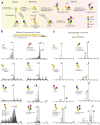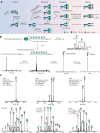Mammalian cell-based production of glycans, glycopeptides and glycomodules
- PMID: 39516489
- PMCID: PMC11549445
- DOI: 10.1038/s41467-024-53738-9
Mammalian cell-based production of glycans, glycopeptides and glycomodules
Abstract
Access to defined glycans and glycoconjugates is pivotal for discovery, dissection, and harnessing of a range of biological functions orchestrated by cellular glycosylation processes and the glycome. We previously employed genetic glycoengineering by nuclease-based gene editing to develop sustainable production of designer glycoprotein therapeutics and cell-based glycan arrays that display glycans in their natural context at the cell surface. However, access to human glycans in formats and quantities that allow structural studies of molecular interactions and use of glycans in biomedical applications currently rely on chemical and chemoenzymatic syntheses associated with considerable labor, waste, and costs. Here, we develop a sustainable and scalable method for production of glycans in glycoengineered mammalian cells by employing secreted Glycocarriers with repeat glycosylation acceptor sequence motifs for different glycans. The Glycocarrier technology provides a flexible production platform for glycans in different formats, including oligosaccharides, glycopeptides, and multimeric glycomodules, and offers wide opportunities for use in bioassays and biomedical applications.
© 2024. The Author(s).
Conflict of interest statement
Y.N., Y.H.C., and H.C. have a financial interest in GlycoDisplay Aps, Y.N., Y.H.C., and H.C.’s interests are reviewed and managed by the University of Copenhagen in accordance with their conflict of interest policies. L.J.v.d.B. has a financial interest in EnzyTag BV. A.S. and E.E.V-C. have a financial interest in VAR2Pharmaceuticals. A.S. has financial interest in VARCT Diagnostics. All other authors declare no competing interests.
Figures





References
-
- Cummings, R. D. The repertoire of glycan determinants in the human glycome. Mol. Biosyst.5, 1087–1104 (2009). - PubMed
-
- Varki, A. et al. In Essentials of Glycobiology 3rd edn (eds Varki, A. et al.) 493–502 (Cold Spring Harbor, 2015).
Publication types
MeSH terms
Substances
Grants and funding
LinkOut - more resources
Full Text Sources

